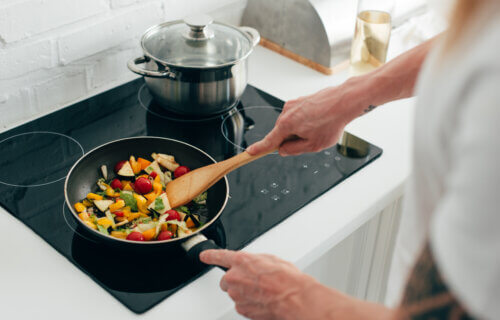When you fire up the stove to whip up a tasty meal, you’re probably not thinking about the tiny particles swirling around your kitchen. But according to a new study, the process of cooking – especially dishes that involve frying or sautéing – releases brown carbon aerosols that could be impacting indoor air quality and ultimately, your health.
So what exactly are these brown carbon aerosols? Essentially, they are microscopic particles that are released into the air from the incomplete combustion of organic matter, like the oils and fats used in cooking. They get their name from their ability to absorb light, giving them a brownish hue. While these particles are too small to see with the naked eye, when they build up, they can contribute to indoor air pollution.
In this study, published in the journal Environmental Science: Atmospheres, researchers from the University of British Columbia set out to investigate whether these cooking-related brown carbon aerosols, which they dubbed “BrCOA”, could produce harmful compounds when exposed to indoor lighting. Specifically, they looked at the production of singlet oxygen – a highly reactive form of oxygen that can damage cells and tissues in the body.
To test this, the scientists whipped up some typical meals – pancakes, pan-fried Brussels sprouts, and vegetable stir-fries. Using an instrument called an impinger, they captured the BrCOA particles released during the cooking process directly into water. Then, they exposed these BrCOA solutions to different types of indoor lighting you’d find in a typical home – sunlight shining through a window, standard fluorescent lights, and UV lights.
What they found was illuminating (pun intended). All of the BrCOA solutions, regardless of the dish they came from, were able to produce singlet oxygen when irradiated with indoor lights. The highest concentrations were seen with the UV and window sunlight, while the fluorescent bulbs resulted in lower singlet oxygen production.
But here’s the kicker – some of the BrCOA samples were much more efficient at generating singlet oxygen than others, even when you accounted for the total amount of brown carbon present. The researchers determined this by calculating something called the “apparent quantum yield,” which is basically a measure of how good a particular sample is at converting absorbed light into a chemical reaction (in this case, singlet oxygen production).
Surprisingly, a BrCOA sample from pan-fried pancakes had the highest apparent quantum yield of over 6%! This suggests that it’s not just the concentration of BrCOA that matters for singlet oxygen formation, but also the specific types of light-absorbing compounds present.
So what does all of this mean for those of us who spend time cooking in our kitchens? Well, the researchers note that singlet oxygen can stick around in the air for a while after it forms, giving it ample opportunity to react with and potentially oxidize other compounds in the indoor environment. Over time, this could degrade indoor air quality.
Additionally, there is growing evidence linking exposure to fine particulate matter from cooking with various health issues. For example, some studies have found associations between cooking aerosols and increased inflammation and oxidative stress in humans.
“Our next steps include determining just how this oxidant might affect humans and how much we’re breathing in when we cook. Could it play a role in some cooking-related diseases?” says senior author Dr. Nadine Borduas-Dedekind, UBC chemistry assistant professor, in a media release.
Now, before you swear off using your frying pan ever again, it’s important to keep things in perspective. The levels of singlet oxygen measured in this study were generally on par with what has been seen outdoors in polluted air – we’re talking concentrations of around 0.26-3.1 parts per trillion. However, the indoor environment is unique in that it’s a much more confined space, which could lead to a buildup of these aerosols over time, especially with poor ventilation.
The good news is there are steps you can take to mitigate your exposure. Using cooking oils with a high smoke point (like avocado oil) can help reduce the formation of brown carbon aerosols in the first place. Always turn on your stove’s exhaust fan or open a window to improve ventilation while cooking. You may also want to consider investing in a portable air purifier with a HEPA filter for your kitchen to help remove any lingering particles.
At the end of the day, more research is needed to fully understand the health implications of cooking-related BrCOA and singlet oxygen production indoors. But this study sheds some important light (again, pun intended) on a previously overlooked source of indoor air pollution. So the next time you’re whipping up a stir-fry or flipping pancakes, just remember to flip on that exhaust fan too – your lungs will thank you!
